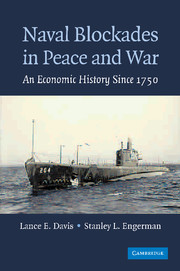Book contents
- Frontmatter
- Contents
- Preface
- 1 Introduction: “Thou Shalt Not Pass”
- 2 Britain, France, and Napoleon's Continental System, 1793–1815
- 3 The United States versus Great Britain, 1776–1815
- 4 The North Blockades the Confederacy, 1861–1865
- 5 International Law and Naval Blockades during World War I: Britain, Germany, and the United States: Traditional Strategies versus the Submarine
- 6 Legal and Economic Aspects of Naval Blockades: The United States, Great Britain, and Germany in World War II
- 7 The American Submarine and Aerial Mine Blockade of the Japanese Home Islands, 1941–1945
- 8 Blockades without War: From Pacific Blockades to Sanctions
- 9 Blockades, War, and International Law: What It All Means
- Conclusion
- Index
3 - The United States versus Great Britain, 1776–1815
Published online by Cambridge University Press: 18 August 2009
- Frontmatter
- Contents
- Preface
- 1 Introduction: “Thou Shalt Not Pass”
- 2 Britain, France, and Napoleon's Continental System, 1793–1815
- 3 The United States versus Great Britain, 1776–1815
- 4 The North Blockades the Confederacy, 1861–1865
- 5 International Law and Naval Blockades during World War I: Britain, Germany, and the United States: Traditional Strategies versus the Submarine
- 6 Legal and Economic Aspects of Naval Blockades: The United States, Great Britain, and Germany in World War II
- 7 The American Submarine and Aerial Mine Blockade of the Japanese Home Islands, 1941–1945
- 8 Blockades without War: From Pacific Blockades to Sanctions
- 9 Blockades, War, and International Law: What It All Means
- Conclusion
- Index
Summary
INTRODUCTION
Although a state of formal war between the United States and Great Britain existed for only 126 of the 477 months between April 17, 1775, and December 24, 1814, a state of near war, including both American embargos and British blockades of the American coast, encompassed much of that thirty-eight and one-half year period that began with the American Declaration of Independence and ended shortly after the signing of the Treaty of Ghent. Given the nature of the period and the interest of this study in the role of international law, it seems most reasonable to temporally divide this chapter into three parts. The first covers the years of the American Revolution (April 17, 1775, to April 15, 1783). The second span the years of “neither war nor peace” (April 1783 to June 19, 1812), when the young republic, because of the maritime focus of its economy, found itself involved as a “neutral” in the ongoing conflict between Britain and France. Finally, the last section will cover the years of the disastrous (at least from the American point of view) War of 1812 – June 1812 until the middle of January 1815.
The roots of the major issue that underlay U.S.-British relations during the entire period rested in a series of British laws – the first of which predated the Declaration of Independence by more than a century and a half.
- Type
- Chapter
- Information
- Naval Blockades in Peace and WarAn Economic History since 1750, pp. 53 - 108Publisher: Cambridge University PressPrint publication year: 2006



